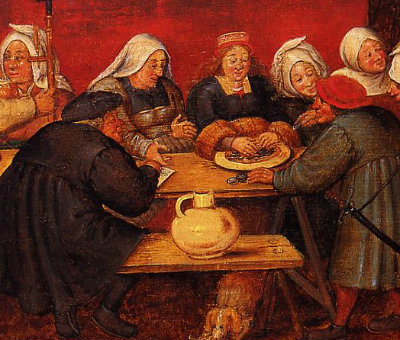Search:: Artists Alphabetically Artists by Country Artists by Century Artists by Movement
Pieter Brueghel the Younger
1564-1638
Stylistically influenced by his father Pieter Brueghel the Elder
technique - oil or tempera on linen or oak panel

.
Pieter Bruegel was born in 1564, although records aren't quite sure that is the correct date. He came from a long line of well known painters, including his famous father, Pieter Brueghel the Elder. When young Pieter was between nine and ten years of age the Bruegelsmoved to Antwerp. Pieter received schooling in math and reading and was began his artistic schooling under Gillis van Coninxloo. Gillis van Coninxloo was acclaimed for his Dutch landscapes.
He worked primarily in Antwerp and Brussels, seldom traveling. He was well regarded not only for his artistic talents but also for his intellect and sophistication. Bruegel painted mainly religious themes and peasant genres. Most of his work is copied or inspired from his fathers paintings. Through his artworks he made fun of the stupidity and wickedness of human kind. He worked almost entirely for private patrons, rarely securing church commissions. He sold many paintings but did not make much of a profit. His work was considered inferior and a bit lackluster compared the elder Bruegel.
Differences Between Northern Renaissance and Italian Renaissance Art
Many of the early paintings of the Northern Renaissance perished through time and the fierceness with which the Iconoclastic battles were waged. The Northern Renaissance was different from the Italian Renaissance in many ways. Painters of the North focused upon secular society rather than the Church and overblown religious themes. Northern Renaissance painters emphasis the daily life of the merchant and peasant class. They also put a greater emphasis on spirituality, piousness and living a simple life. Artists such as Dieric Bouts and Peter Brugal the Elder painted inspirational biblical scenes, the merchant class at work, idyllic scenes of peasants working at everyday tasks, playing games and feasting. Oil paint was invented by Northern Renaissance painters. According to art historian John C. Van Dyke "The chief medium was oil, used upon panel or canvas. Fresco was probably used in the early days, but the climate was too damp for it and it was abandoned. It was perhaps the dampness of the northern climate that led to the adaptation of the oil medium, something the Van Eycks are credited with inaugurating."The Italian Renaissance, on the other hand, focused more on the aristocracy and the theocracy. Painters highlighted the individual and glorified worldly pleasures, Paintings were sumptuous, elaborate, expressive, and exhalted wealthy and powerful people. Author Clive Bell observed "But whatever the Italian painters of the Renaissance had to say they said in the grand manner. Remember, we are not Dutchmen. Therefore let all your figures suggest the appropriate emotion by means of the appropriate gesture—the gesture consecrated by the great tradition. Straining limbs, looks of love, hate, envy, fear and horror, up-turned or downcast eyes, hands outstretched or clasped in despair."
The Italian Renaissance painters focused heavily on religion, Roman Catholicism. Popes and church hierarchy were wealthy, powerful rulers. Like kings they were depicted in elaborate settings swaddled in furs and silks.
Require more facts and information about Rogier van der Weyden and Art history? Dig around every nook and cranny of the known universe for information this subject. Search Here
☼☼☼☼☼
© HistoryofPainters.com If you like this page and wish to share it, you are welcome to link to it, with our thanks. updated 3/7/2017